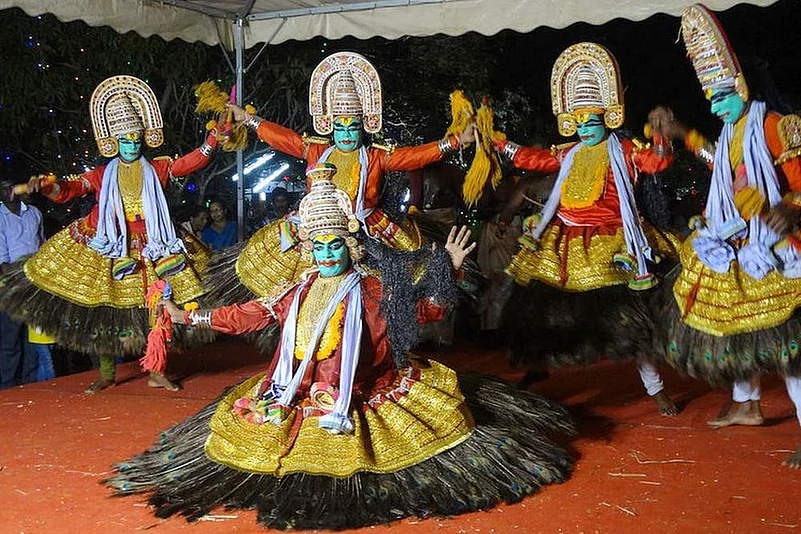As a child, he would play a game that used to be called ‘temple’. Kids in the locality of the village assembled in open compounds, where the little boy would hold a lookalike bow-and-arrow and recite songs from a folk art endemic to their verdant south-central Kerala. At this, an amused family head would call out with a smirk: “Who are you? Palamoottil Kumaran or what!”
Now, that was the name of an iconic exponent known for the art the pre-teenager was trying to imitate: Mayilpeeli Thookkam. Paradoxically, this was in the 1970s when the ritual form was facing a rot verging on extinction. That apart, years later, the same lad went on to rediscover the charms of the pre-classical art. Thus came out a recent book by Sajaneev Ittithanam, profiling the entire details of a north Travancore form that has made a comeback in the districts of Kottayam and Alappuzha.
Advertisement
The 240-page work plumbs the details of the folk art that had played a role in the aesthetics of its author, who is currently employed in a state government department. He even underwent formal training in Mayilpeeli Thookkam under Kiliroor P.K. Ramakrishna Kurup, who is from one of those communities that had been traditionally allied to this all-male art (which has had practitioners from almost all castes except Brahmins). Ezhavas and the conventionally subaltern Ashari and Kollan (traditionally engaged with carpentry and foundry respectively) are widely the present-day exponents of Mayilpeeli Thookkam, notes the eponymous book backed with multi-colour photos and published with by SPCS.
Advertisement

At the outset, Sajaneev, who is also a lyricist for contemporary plays and television serials, explains why Mayilpeeli Thookkam has also come to be known as Arjuna Nritham. Legend has it that the characters represent the middle Pandava, who readied himself for self-sacrifice before Kaali to keep a promise his mother had made in the hope of an end to an earlier phase of difficult life for the family. The mythological extension of the tale goes that the goddess was pleased with the looks of Arjuna that she withdrew her condition. That appearance of the prince is said to have drawn the basic sketch for the facial makeup and body costume of Mayilpeeli Thookkam dancers.
The purana story also says that the goddess, pleased with Arjuna’s devotion, gifted him a holy bait. This, the author of the book says, is behind why Mayilpeeli Thookkam artistes are also seen hung from the roof of a chariot during a circular procession at the Devi shrine hosting the evening event.
In a point-by-point description of the key characteristics of the art, the author notes a key sacrificial ritual of Mayilpeeli Thookkam has of late got modified with the cutting of the ash gourd stuffed with a mix of paste lime (the white mineral) and grounded turmeric that makes is red-coloured.
Advertisement
Another highlight comes as an introductory paragraph here when the author points out the richness of rhythmic patterns in Mayilpeeli Thookam. More than a dozen common talas in the art have a practical history dating back to the 13th century going by a couple of treatises. Focusing on this fact, scholar Manoj Kuroor observes that a long and deep journey into the rhythmic aspects of Mayilpeeli Thookam makes the book an essential reference for art-lovers in a state like Kerala, which has a rich and ancient variety of talas.
In his foreword, Dr Kuroor also recalls how his efforts more than a quarter century ago to document Mayilpeeli Thookam didn’t bear fruit owing to reluctance by master Kurichi Kumaran, who later expressed willingness to cooperate but died soon after. That tragedy had led Dr Kuroor to believe that the last ray of hope on a authentic work on Mayilpeeli Thookam was extinguished, but now—to his joy—it has come out from Sajaneev, who he had first seen passionately speaking about Mayilpeeli Thookkam at a public talk.
Advertisement

Sajaneev, who has penned a story-play Mathavilasam based on a work in the same name by 7th-century Pallava king Mahendravarman, notes about an indigenous instrument called makudam that used to be integral to the percussion of Mayilpeeli Thookam. This can be traced as a prototype of the more used maddalam of present days, he notes about the art form now using the vertical chenda drum in a big way. Further, the popular Ottan Thullal has its ornate headgear in inverted U-shape borrowed from Mayilpeeli Thookkam.
As for the literature, this art revels in what is called devotion-tinged songs called ‘Kavittham’. Its Malayalam verses are laced with Tamil, indicating the prevalence of Mayilpeeli Thookkam to a time when the land strips on both sides of the Western Ghats did not have a cultural segregation as distinct as today.
Advertisement
Overall, practitioners of this form require profound knowledge about literary measures, rhythmic patterns, Hindu mythology and even Vedanta, the author points out, underling the reasons.
The book, which essays the tala cycles, dance movements and literary matters of Mayilpeeli Thookkam, also featured basic info (with photos) of its renowned masters of recent times as well as the images of vintage temples that host the art that also finds depiction in festive pageantries without ritualistic flavour.
“My work is a tribute to those yesteryear ashans (masters) who hid their starving bellies with the beautiful peacock feathers hanging from the waist,” notes Sajaneev, a history enthusiast who works as a sub-engineer in the Kerala State Electricity Board.




















